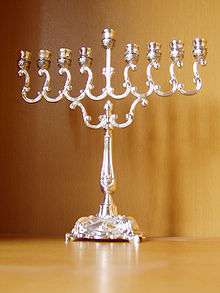Buñuelo
|
Round Colombian buñuelos | |
| Alternative names | Bimuelo, birmuelo, bermuelo, burmuelo, bonuelo |
|---|---|
| Type | Doughnut |
| Place of origin | Spain |
A buñuelo (Spanish: [buˈɲwelo]; alternatively called bimuelo, birmuelo, bermuelo, burmuelo, or bonuelo; Catalan: bunyol, IPA: [buˈɲɔl]) is a fried dough ball. It is a popular snack in Venezuela, Argentina, Belize, Bolivia, Colombia, Cuba, Ecuador, El Salvador, Greece, Guam, Guatemala, Israel, Mexico, Africa, Nicaragua, the Philippines, Puerto Rico, Spain, Turkey, Uruguay, and Venezuela. It traditionally prepared at Christmas, Ramadan, and among Sephardic Jews at Hanukkah. It will usually have a filling or a topping. In Mexican cuisine, it is often served with a syrup made with piloncillo.[1]
Buñuelos are first known to have been consumed among Spain's Morisco population. They typically consist of a simple, wheat-based yeast dough, often flavored with anise, that is thinly rolled, cut or shaped into individual pieces, then fried and finished off with a sweet topping. Buñuelos may be filled with a variety of things, sweet or savory. They can be round in ball shapes or disc shaped. In Latin America, buñuelos are seen as a symbol of good luck.[2]
Regional adaptations
- In Colombia they are made with a small curd white cheese and formed into doughy balls then fried golden brown. It is a traditional Christmas dish, served along with natillas and manjar blanco.
- In Cuba they are traditionally twisted in a figure 8 and covered in an anise caramel. The dough contains cassava and malanga.
- In the Dominican Republic, buñuelos are rolled into balls from a dough made of cassava (called yuca) and eggs. They are then covered in a cinnamon sugar syrup, often using coconut milk instead of water.
- In Nicaragua, buñuelos are made from a dough containing cassava, eggs, and white grating cheese. The buñuelos are rolled into balls and deep fried. They are served alongside a syrup made of sugar, water, cinnamon sticks, and cloves. They are eaten year-round, and are a typical side-dish or snack served during holidays.
- In Puerto Rico, buñuelos are small and round. The dough is often made with milk, baking powder, egg, flour, apio or cassava, or grated corn that has been squeezed through a cheesecloth. They are often filled with cheese, ham, spices, and then baked. Sweet buñuelo dough contains yam or batata filled with guava and cream cheese and usually fried.
- In Mexico buñuelos are made from a yeasted dough with a hint of anise that is deep-fried, then drenched in a syrup of brown sugar, cinnamon, and guava. Buñuelos are commonly served in Mexico and other Latin American countries with powdered sugar, a cinnamon and sugar topping, or hot sugar cane syrup (piloncillo) and are sold in fairs, carnivals, and Christmas events such as Las Posadas.
- In Peru, buñuelos resemble picarones in shape (round and ring shaped) but lack yam or squashes as in picarones. Made of flour, water, sugar, and anise, and yeast. They are served with a sweet syrup made of chancaca (sugar cane derived sweet). Common street food native to Arequipa.
- in Uruguay sweet buñuelos are made with apples and bananas and covered in sugar. Salty variations are traditionally made of spinach, cow brains and seaweed. Cow brains were banned at the country due to mad cow disease of 1996 in England. Seaweed buñuelos are considered a delicacy in Rocha Department.
There are references to buñuelos in Majorca, Catalonia or Valencia; there are also buñuelos in Turkey, India, Puerto Rico, and Cuba; buñuelos in Russia. Jews in Turkey make buñuelos with matzo meal and eat them during Passover. They are also popular during Hanukkah.
In many Latin American countries, this particular dish can also be made with flour tortillas, and covered in sugar and/or cinnamon.
See also
References
- ↑ Grodinsky, Peggy (6 September 2006). "Pump up the flavor with piloncillo". Houston Chronicle. Retrieved 23 January 2014.
- ↑ Herrera, Jennifer. "Buñuelos: Tasty dessert symbolic of good luck". San Antonio Express-News. Retrieved 3 March 2015.
External links
| Wikimedia Commons has media related to Buñuelos. |
| Wikibooks Cookbook has a recipe/module on |
